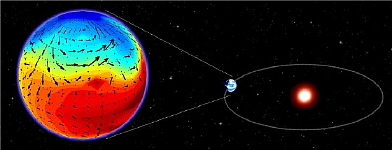

| Visitors Now: | |
| Total Visits: | |
| Total Stories: |

| Story Views | |
| Now: | |
| Last Hour: | |
| Last 24 Hours: | |
| Total: | |
Astrophysics: “First Habitable Exoplanet: Gliese 581”
by Alton Parrish
In this quest, the red dwarf star Gliese 581 has already received a huge amount of attention. In 2007, scientists reported the detection of two planets orbiting not far from the inner and outer edge of its habitable zone. While the more distant planet, Gliese 581d, was initially judged to be too cold for life, the closer-in planet was thought to be potentially habitable by its discoverers. However, later analysis by atmospheric experts showed that if it had liquid oceans like Earth, they would rapidly evaporate in a ‘runaway greenhouse’ effect similar to that which gave Venus the hot, inhospitable climate it has today.
Today, it is finally Gliese 581g’s big brother – the larger and more distant Gliese 581d – which has been shown to be the confirmed potentially habitable exoplanet by Robin Wordsworth, François Forget and co-workers from Laboratoire de Météorologie Dynamique (CNRS, UPMC, ENS Paris, Ecole Polytechnique) at the Institute Pierre Simon Laplace in Paris. Although it is likely to be a rocky planet, it has a mass at least seven times that of Earth, and is estimated to be about twice its size. At first glance, Gliese 581d is a pretty poor candidate in the hunt for life: it receives less than a third of the stellar energy Earth does and may be tidally locked, with a permanent day and night side. After its discovery, it was generally believed that any atmosphere thick enough to keep the planet warm would become cold enough on the night side to freeze out entirely, ruining any prospects for a habitable climate.
To test whether this intuition was correct, Wordsworth and colleagues developed a new kind of computer model capable of accurately simulating possible exoplanet climates. The model simulates a planet’s atmosphere and surface in three dimensions, rather like those used to study climate change on Earth. However, it is based on more fundamental physical principles, allowing the simulation of a much wider range of conditions than would otherwise be possible, including any atmospheric cocktail of gases, clouds and aerosols.
To their surprise, they found that with a dense carbon dioxide atmosphere – a likely scenario on such a large planet – the climate of Gliese 581d is not only stable against collapse, but warm enough to have oceans, clouds and rainfall. One of the key factors in their results was Rayleigh scattering, the phenomenon that makes the sky blue on Earth. In the Solar System, Rayleigh scattering limits the amount of sunlight a thick atmosphere can absorb, because a large portion of the scattered blue light is immediately reflected back to space. However, as the starlight from Gliese 581 is red, it is almost unaffected. This means that it can penetrate much deeper into the atmosphere, where it heats the planet effectively due to the greenhouse effect of the CO2 atmosphere, combined with that of the carbon dioxide ice clouds predicted to form at high altitudes. Furthermore, the 3D circulation simulations showed that the daylight heating was efficiently redistributed across the planet by the atmosphere, preventing atmospheric collapse on the night side or at the poles.
Scientists are particularly excited by the fact that at 20 light years from Earth, Gliese 581d is one of our closest galactic neighbours. For now, this is of limited use for budding interstellar colonists – the furthest-travelled man-made spacecraft, Voyager 1, would still take over 300,000 years to arrive there. However, it does mean that in the future telescopes will be able to detect the planet’s atmosphere directly. While Gliese 581d may be habitable there are other possibilities; it could have kept some atmospheric hydrogen, like Uranus and Neptune, or the fierce wind from its star during its infancy could even have torn its atmosphere away entirely. To distinguish between these different scenarios, Wordsworth and co-workers came up with several simple tests that observers will be able to perform in future with a sufficiently powerful telescope.
Citation: “Gliese 581d is the first discovered terrestrial-mass exoplanet in the habitable zone”. R.D. Wordsworth, F. Forget, F. Selsis, E. Millour, B. Charnay, J-B. Madeleine. “The Astrophysical Journal Letters,” May 12, 2011.
Source:



